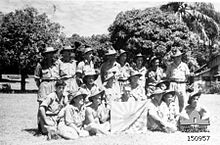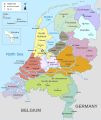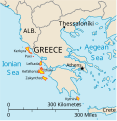The Islands Portal
This is a list of the lists of islands in the world grouped by country, by continent, by body of water, and by other classifications. For rank-order lists, see the other lists of islands below. (Full article...)
Selected article –
The Battle of Goodenough Island (22–27 October 1942), also known as Operation Drake, was a battle of the Pacific campaign of World War II. The Allies landed on Goodenough Island, Papua, and clashed with a Japanese Kaigun Rikusentai (Special Naval Landing Force). The Japanese troops had been stranded on the island during the Battle of Milne Bay in late August 1942. "Drake Force", consisting of the Australian 2/12th Battalion and attachments, landed on the southern tip of Goodenough Island at Mud Bay and Taleba Bay on 22 October, tasked with denying the Japanese use of the island prior to the Buna campaign. Following a short but intense fight, the Japanese forces withdrew to Fergusson Island on 27 October. After the battle, Goodenough Island was developed into a major Allied base for operations later in the war. (Full article...)
Selected cuisines, dishes and foods –

Menorcan cuisine refers to the typical food and drink of Menorca.
Menorca is a rocky island in the Balearic archipelago in Spain, consisting of eight municipalities. Featuring a Mediterranean climate, the weather is milder in the south while in the north there are strong winds all year round. Marine salt, carried by the wind to the pastures where cows graze, is what gives the cheese its typical flavour. Seafood is a major element of the island's cuisine, but additionally, there are horses, pigs (used for cold cuts) and cows (the skin of which is used to produce leather, and the milk to produce cheese). Agriculture is small-scale and varied, consisting of typical Mediterranean products. Within this typical Mediterranean cuisine there are also the influences of various invading people, particularly the English, who brought plum cake, puddings, and punch. The rural and marine cuisine is mostly based on greens and vegetables from one's own garden, locally produced meat, and fish and seafood caught in the same day. Olive oil, although not produced on the island, is also a fundamental ingredient in local dishes. (Full article...)Related articles
- List articles
- List of islands
- List of islands by area
- List of islands by highest point
- List of islands by name
- List of islands by population
- List of islands by population density
- List of archipelagos
- List of archipelagos by number of islands
- List of artificial islands
- List of divided islands
- List of fictional islands
- List of island countries
- List of islands in lakes
- List of islands named after people
- List of islands of the European Union
- List of private islands
Selected image –
Did you know –

- ... that when a Russian warship asked the Ukrainian defenders of Snake Island to surrender, their response was "Russian warship, go fuck yourself"?
- ... that the ancient Hawaiian village known as the Kāneiolouma Complex is across the street from a popular beach on the island of Kauaʻi?
- ... that the Love Island series 8 contestant Tasha Ghouri went viral in early 2024 after uploading a video to TikTok using her "deaf accent"?
- ... that the bridge on the R565 road to Valentia Island was opened twice?
- ... that the name of the Noises, a group of islands in New Zealand, is a corrupted version of Les Noisettes ("the Hazelnuts")?
- ... that Long Island's PBS station specialized in making shows for other stations to air during their pledge drives?
General images –
Related portals
WikiProjects
Topics
Categories
Associated Wikimedia
The following Wikimedia Foundation sister projects provide more on this subject:
-
 Commons
Commons
Free media repository -
 Wikibooks
Wikibooks
Free textbooks and manuals -
 Wikidata
Wikidata
Free knowledge base -
 Wikinews
Wikinews
Free-content news -
 Wikiquote
Wikiquote
Collection of quotations -
 Wikisource
Wikisource
Free-content library -
 Wikiversity
Wikiversity
Free learning tools -
 Wikivoyage
Wikivoyage
Free travel guide -
 Wiktionary
Wiktionary
Dictionary and thesaurus
Things to do
 |
Here are some tasks awaiting attention:
|
Web resources
- Listing of islands from the United Nations Island Directory

































![Image 30The Shamanka Шаманка [ru], a holy rock in Shamanism and one of the 9 most holy places in Asia, on the westcoast of Olkhon (from List of islands of Russia)](https://upload.wikimedia.org/wikipedia/commons/thumb/2/27/Shaman_Kamen.jpg/120px-Shaman_Kamen.jpg)



























































Recent Comments